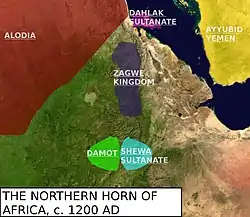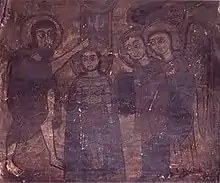Zagwe dynasty
The Zagwe dynasty (Ge'ez: ዛጔ ሥርወ መንግሥት) was the ruling dynasty of a medieval kingdom in present-day northern Ethiopia. The kingdom itself was perhaps called Begwena, after the historical name of the Lasta province.[1] Centered at Lalibela, it ruled large parts of the territory from approximately 900 to 1270, when the last Zagwe King Za-Ilmaknun was killed in battle by the forces of the Abyssinian King Yekuno Amlak. The name of the dynasty is thought to derive from the ancient Ge'ez phrase Ze-Agaw, meaning "opponent", in reference to the Mara Tekle Hymanote, the founder of the dynasty.[2] Zagwe's best-known King was Gebre Mesqel Lalibela, who is credited with having constructed the rock-hewn monolithic churches of Lalibela.
Zagwe Dynasty ዛጔ ሥርወ መንግሥት | |||||||||
|---|---|---|---|---|---|---|---|---|---|
| c. 900/1137–1270 | |||||||||
 The Zagwe kingdom and its neighbours | |||||||||
| Capital | Lalibela | ||||||||
| Common languages | Amharic, Agaw, Ge'ez | ||||||||
| Government | Monarchy | ||||||||
| King | |||||||||
• early 12th century | Mara Takla Haymanot | ||||||||
• 13th century | Yetbarak | ||||||||
| History | |||||||||
• Established | c. 900/1137 | ||||||||
• Disestablished | 1270 | ||||||||
| |||||||||
David Buxton has stated that the area under the direct rule of the Zagwe kings "probably embraced the highlands of modern Eritrea and the whole of Tigray, extending southwards to Waag, Lasta and (Wollo province) and thence westwards towards Lake Tana (Begemder)."[3] Unlike the practice of later rulers of Ethiopia, Taddesse Tamrat argues that under the Zagwe dynasty the order of succession was that of brother succeeding brother as king, based on the Agaw laws of inheritance.
History

Part of a series on the |
|---|
| History of Ethiopia |
 |

Around 960, Queen Gudit destroyed the remnants of the Kingdom of Aksum, causing a shift in its temporal power centre that later regrouped more to the south. For 40 years she ruled over what remained of the kingdom, eventually passing on the throne to her descendants. According to other Ethiopian traditional accounts, the last of her dynasty was overthrown by Mara Takla Haymanot in 1137. He married a daughter of the last king of Aksum, Dil Na'od. Since he married Emperor Dil Na'od's daughter, who was a member of the Solomonic Dynasty, the Zagwes are technically part of the Solomonic lineage. Emperor Mara Tekla Haymanot's marriage and off-spring thereof makes him the only Emperor without claimed ties to the Biblical King Solomon and Makeda, the Queen of Sheba.
The Zagwe period is still shrouded in mystery; even the number of kings in this dynasty is disputed. Some sources (such as the Paris Chronicle, and manuscripts Bruce 88, 91, and 93) give the names of eleven kings who ruled for 354 years; others (among them the book Pedro Páez and Manuel de Almeida saw at Axum) list only five who ruled 143.[4] Paul B. Henze reports the existence of at least one list containing 16 names.[5]
According to Carlo Conti Rossini, the shorter mooted length of this dynasty is the more likely one. He argues that a letter received by the Patriarch of Alexandria John V shortly before 1150 from an unnamed Ethiopian monarch, in which the Patriarch is asked for a new abuna because the current office holder was too old, was from Mara Takla Haymanot, who wanted the abuna replaced because he would not endorse the new dynasty.[6]
The mystery of the Zagwe dynasty is perhaps darkest around its replacement by the revived Solomonic dynasty under Yekuno Amlak. The name of the last Zagwe king is lost—the surviving chronicles and oral traditions give his name as Za-Ilmaknun, which is clearly a pseudonym (Taddesse Tamrat translates it as "The Unknown, the hidden one"), employed soon after his reign by the victorious Solomonic rulers in an act of damnatio memoriae. Taddesse Tamrat believes that this last ruler was actually Yetbarak. The end of the Zagwe came when Yekuno Amlak, who proclaimed himself the descendant and rightful heir of Dil Na'od, and acting under the guidance of either Saint Tekle Haymanot or Saint Iyasus Mo'a, pursued the last king of the Zagwe and killed him at the church of St. Qirqos in Gaynt on the north side of the Bashilo River.[7]
Foreign relations

Unlike Aksum, the Zagwe were virtually unknown to the contemporary powers of the Mediterranean. The only regular relations seem to have been maintained with Egypt and Jerusalem.[8] Although their presence is often claimed to have been of considerable antiquity, it is only in the 11th and 12th centuries when Ethiopians are firmly attested to have lived in Egypt.[9] A rare testament for their presence during the reign of the Zagwe is a fragmentary manuscript written in Ge'ez that was recently discovered in the Monastery of Saint Anthony, dating to the mid-12th to mid-13th centuries.[10]
The common notion that Saladin granted concessions to the Ethiopian church in Jerusalem after his conquest of the town in 1187 is based on a faked source from the 19th century. The earliest sources confirming an Ethiopian community in Jerusalem date to the second half of the 13th century.[11] Yet it is still probable that Ethiopians had lived there before. In the late 12th century, King Lalibela's knowledge of the town was sufficient enough to have inspired him during the expansion of his capital, adopting Jerusalem's form, attributions and toponyms.[12]
See also
- Ethiopian historiography
- History of Ethiopia
- Kings of Axum
- List of Emperors of Ethiopia
Notes
- Marie-Laure Derat (2010): "The Zagwe dynasty (11-13th centuries) and King Yemrehanna Krestos" in "Annales d'Ethiopie 25". p. 172
- Roland Oliver, The Cambridge history of Africa: From c. 1600 to c. 1790, Volume 1 (Cambridge University Press: 1982), p.112.
- David Buxon, The Abyssinians (New York: Praeger, 1970), p. 44
- G.W.B. Huntingford, "'The Wealth of Kings' and the End of the Zāguē Dynasty", Bulletin of the School of Oriental and African Studies, 28 (1965), p. 8
- Henze, Layers of Time (New York: Palgave, 2000), p. 50 n.19
- Taddesse Tamrat, Church and State in Ethiopia (Oxford: Clarendon Press, 1972), pp. 56ff
- G.W.B. Huntingford, "'The Wealth of Kings'", p. 2
- Bausi, Alessandro (2017): "The Zagwe" in Ethiopia. History, Culture and Challenges. p. 108
- El-Antony, Fr. Maximous; Blid, Jesper (2016: "An Early Ethiopic Manuscript Fragment (Twelfth–Thirteenth Century) from the Monastery of St Antony (Egypt)" in Aethiopica 19. pp. 47–-48
- El-Antony, Fr. Maximous; Blid, Jesper (2016: "An Early Ethiopic Manuscript Fragment (Twelfth–Thirteenth Century) from the Monastery of St Antony (Egypt)" in Aethiopica 19. p. 45
- van Donzel, E. (1999): "Were there Ethiopians in Jerusalem at the Time of Saladin's Conquest in 1187?" in East and West in the Crusader States: Context-Contacts-Confrontations II
- Phillipson, David W. (2018): "Jerusalem and the Ethiopian Church. The Evidence of Roha (Lalibela)" in Tomb and Temple: Re-imagining the Sacred Buildings of Jerusalem. pp. 261-266
External links
Further reading
- Derat, M.-L. (2018). L'énigme d'une dynastie sainte et usurpatrice dans le royaume chrétien d'Ethiopie, XIe-XIIIe siècle (in French). Brepolis. ISBN 978-2-503-57908-5.CS1 maint: ref=harv (link)